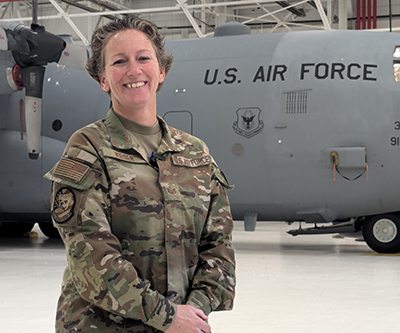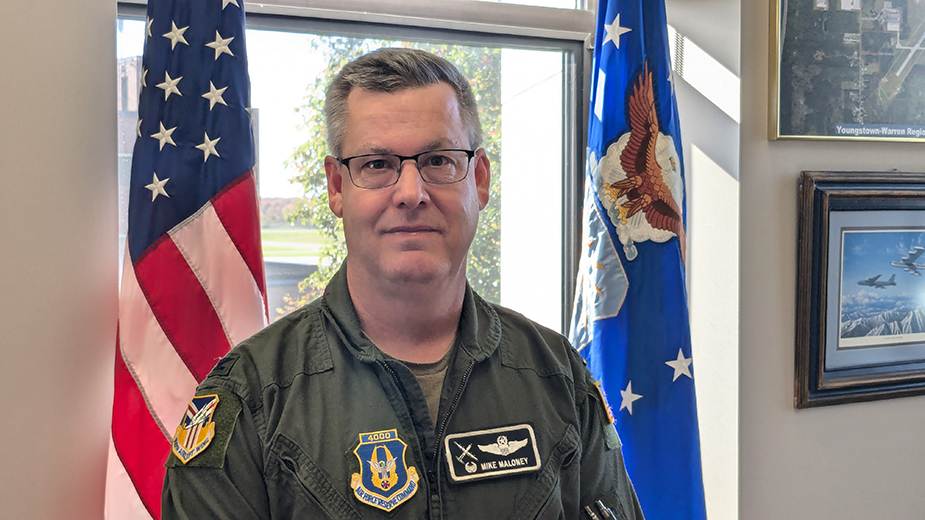YOUNGSTOWN, Ohio – Col. Michael Maloney often likens his duties to that of a small-town mayor.
There’s one big difference, of course: This small town is an economic engine charged with providing services and defending U.S. interests around the world.
As the commander of the 910th Airlift Wing and installation commander of the Youngstown Air Reserve Station in Vienna, Maloney supervises an operation that ranges from routine and mundane business to making decisions vital to the country’s defense.
“Our mission is agile combat support, tactical airlift and aerial spray,” Maloney says, noting that those on the base serve in occupations found in any local community.
Medical personnel, accountants, chefs, maintenance specialists, civil engineers, human relations directors, pilots, logistics specialists, information and cybersecurity technology experts, firefighters, security and safety forces – these capacities and more are filled by the 1,900 Air Force reservists and civilian workers employed at the base.
The Missions
Approximately 70% of those at the Youngstown Air Reserve Station are considered part-time, Maloney says. The remainder – or approximately 400 – are full-time staff. “Our reservists are drawn from 15 to 20 states in the northeast region, mainly from Ohio and Pennsylvania,” he says.
Maloney says the YARS agile combat support mission relies on reservists’ specialties and skills that help forces in forward areas. “It’s everything it takes to support air power or a unified force,” he says. Everyone from HVAC technicians, civil engineers needed for rapid runway repairs. Nurses, flight surgeons, dentists and cyber specialists are among those that could deploy at any moment’s notice. “Their job is not just to run this base,” he says. “Their job is to also deploy overseas for combatant commanders and support the entire Department of Defense and our allies.”
Maloney points to a hypothetical situation in the Pacific, for example. “We might have a base there that needs support for cyber defense,” he says. “They can call on the 910th Airlift Wing and my cyber folks would forward deploy to support it.”
The commander acknowledges that YARS is best known to the public for its fleet of eight C-130 aircraft. “Everyone thinks of C-130s – and they’re the heart and soul of this base – but it’s a lot broader than that,” he says. There are occasions, Maloney notes, when specialists at the base – say a firefighter – might be called to duty without activating a C-130 team. “We deploy in many different ways,” he says. “In an ideal deployment, we’d all go together. But that’s not how the world is operating right now.”

A second mission is the YARS’ tactical airlift operation, Maloney says. These are operations also vital to forward areas and humanitarian efforts that may require a constant stream of supplies – food, water, ammunition, troops.
The base’s workhorse, the C-130H Hercules, and the recently acquired C-130J Super Hercules, provide air transportation to drop or deliver reinforcements or critical supplies to installations all over the world.
“We fly every day,” Maloney says. Most of the C-130s at the base were first manufactured during the 1980s, rendering them obsolescent. The first of the new C-130Js arrived in July and the base is slated to receive seven more over the next two years to replace the aging fleet.
“The H model was incredibly reliable,” Maloney says. However, the C-130Js point to the future of the mission and the base, because the aircraft possesses superior technological functions that makes it easier to integrate into modern U.S. Air Force operations. “It’s important to keep apace with technological developments,” he says.
Each of the base’s C-130s can be configured to accommodate the 910th Aerial Spray unit. The 910th’s mission is the only U.S. Department of Defense operation with aerial spray capability.
The 910th conducts aerial spray operations on a recurring basis at defense installations in Arizona, Florida, Idaho, Georgia, Kansas, North Dakota, South Dakota, Utah and Virginia. These missions are used to neutralize oil spills, to control vegetation on bombing and test ranges, and insect control. The unit has proven effective in combating insect infestation after major natural disasters, such as hurricanes. In October 2020, the 910th conducted aerial spray operations in southern Louisiana to combat mosquitos in the aftermath of hurricanes Laura and Delta.
“I have an amazing front staff,” Maloney says. “On one hand, I have to be an administrator of a small town, but also be responsible for organizing, training and equipping all these airmen to deploy overseas in a potential combat environment.”
Four subordinate colonels serve under the commander at the 910th. They head different divisions: an operations group, a maintenance group, a medical squadron, and a mission support group.
Daily Work at the Base
For Jessica White, joining the Air Force Reserve changed her life.

Today, White serves as the civilian personnel officer, a full-time position at the Youngstown Air Reserve Station. She is also a reservist at the 911th Wing in Pittsburgh.
“I joined the reserves 20 years ago,” she says. “My little sister inspired me to join.”
As a single mother living in Warren, White could not sign up for active duty and opted for the reserves. Through her service, she was able to earn a degree from the Community College of the Air Force, which helped her land the job at the base. Moreover, she says, the reserves have presented remarkable opportunities and experiences.
“It’s opened my eyes,” White says. “Being from Warren and then having to see the world, it definitely gave me a great perspective.”
White manages all human resources for civilian personnel employed at the base, all of whom serve in a variety of occupations. There are 394 civilians employed at YARS, she says. “I love my job,” she says.
In other base operations, full-time personnel are busy readying training equipment and preparing logistics for reservists.
“Our job is to make sure that everything is ready to go for reservist training and readiness,” says Master Sgt. Rebekah Sines, an assistant aeroport engineer. “When they are headed out the door, they are capable and ready to go.”

Sines manages reservist training for supply drops, which constitutes dropping cargo-laden pallets rigged with parachutes. Or, the cargo is prepared for combat offload training, in which material is unloaded from a C-130 aircraft as it is in motion on a runway.
“We do aerial delivery – not every base has this,” she says. “We provide operations with the training they need for air drops so they remain current and ready for when they do real missions.”
On a Thursday in late October, Sines points to several pallets on the hangar floor containing a composite material – rumber – that is heavy, but durable, and perfect for training purposes. Other pallets contain smaller containers that during a mission would be used for supplies such as ready-to-eat meals, medicine, ammunition, blood or water.
On the other side of the building, large parachutes dangle from the ceiling and await rigging.
Although many of these reservists are trained for drops in combat zones, the 910th also provides these supplies for humanitarian missions, such as recent drops over Guatemala.
Sines says pilots and their crews use drop zones at Camp Garfield in Ravenna for training purposes. “We usually do the drops Tuesday and Thursday evenings,” she says.
Aircraft maintenance work is another critical occupation at the air base, especially since the reserve station will over the next two years replace its existing fleet of C-130s.

“I am in charge of all the maintenance on the aircraft,” says Staff Sgt. Danielle Wiesen, a C-130 crew chief and maintainer. “I’m the one that says it’s air-worthy and turn it over to ops and say you guys are able to fly it.”
Wiesen is assigned a single aircraft to oversee, a C-130H that is parked in a large hangar at the base. Additional training, she notes, will be necessary once more of the modern C-130Js arrive.
“It’s like moving from a muscle car to a Tesla,” she says of the difference between the two aircraft.
She recalls that she wanted to join the military right after high school but was discouraged from doing so by her father. Years later, her father relented. He suggested she enlist.
“I was 37 years old, and I wanted in,” she says. “I wanted to do something different.”
Her preparation for this job consisted of six months of basic training and another six months of technical school, where she studied the systems and operations of the C-130. “There is a lot of studying,” Wiesen says. “Then, you come back and do additional training,”
Wiesen says as a crew chief, she relies on specialists to inspect and work on certain parts of the aircraft such as engines and avionics. “As a crew chief, you dabble in everything,” she says. “What I love is that no two days are the same.”
Economic Impact and Future of YARS
The Youngstown Air Reserve Station is among the largest employers in the Mahoning Valley, and its economic impact is important to the region’s economy, officials say.
Josh Prest, executive director for the Eastern Ohio Military Affairs Commission, or EOMAC, says over the last 10 years, the base has pumped approximately $500 million into the local economy.
“There’s been a sizeable contribution,” he says.
EOMAC lobbies on behalf of the Youngstown Air Reserve Station and Camp Garfield to legislators and decision makers in Columbus and Washington, Prest says. “The military can’t go out and lobby. So that’s what we do,” he says.
In 2022, EOMAC estimated that the air base yielded more than $140 million in economic impact, Prest says, and it’s likely more investment will follow in the coming years to support the arrival of the new C-130Js, a program that alone cost $879 million for the aircraft.
These factors point to the Air Force’s long-term confidence in Youngstown’s operations, commander Maloney says.
“One of the things the Air Force looks at is community support,” he relates, noting that over the course of his career – this is his 14th assignment – the Mahoning Valley has stepped up more than any other, such as engaging the base with businesses and education.
“These are little things this community has done more than any community I’ve been a part of,” Maloney says. “The future is very bright for Youngstown.”
Pictured at top: Col. Michael Maloney is the commander of the 910th Airlift Wing and installation commander of the Youngstown Air Reserve Station.
